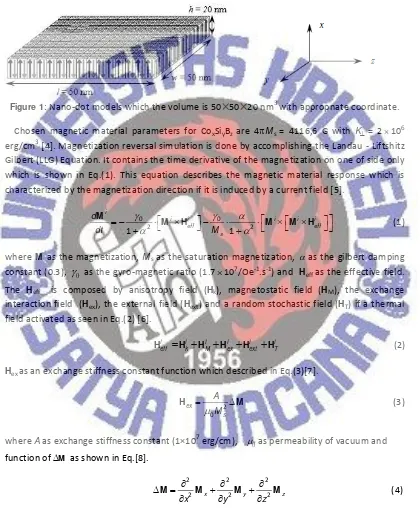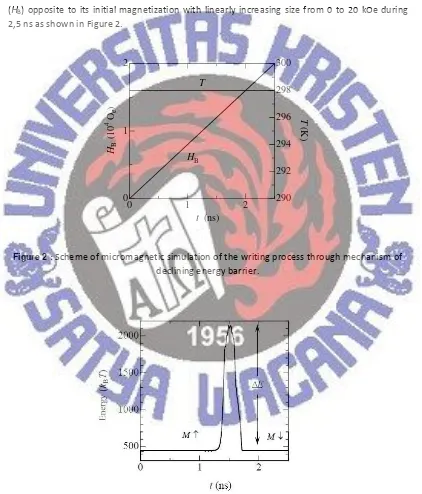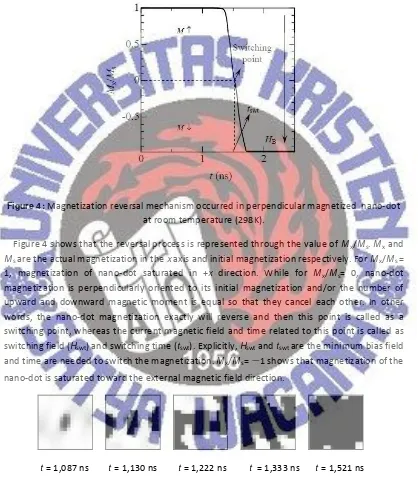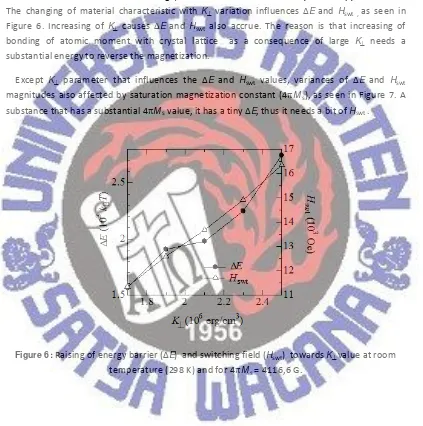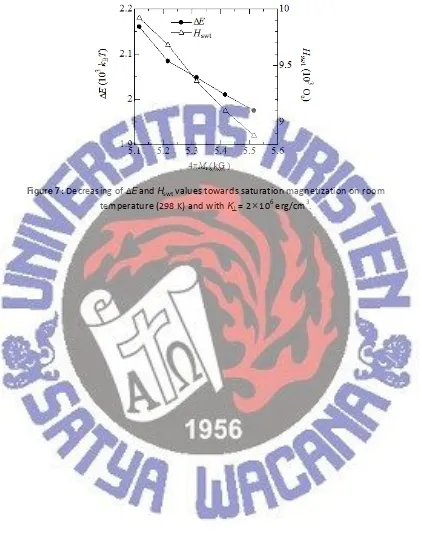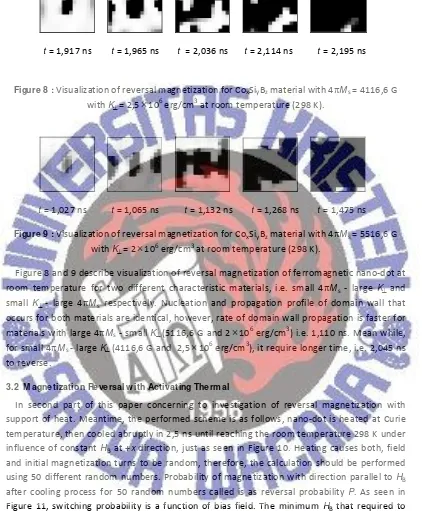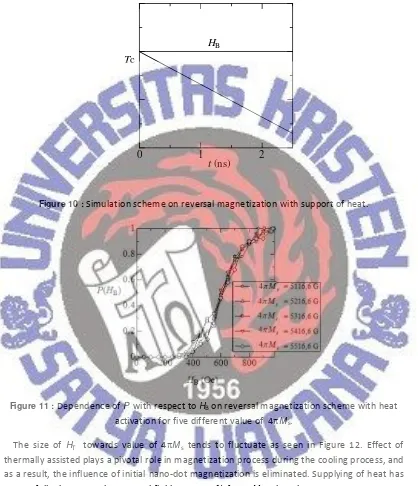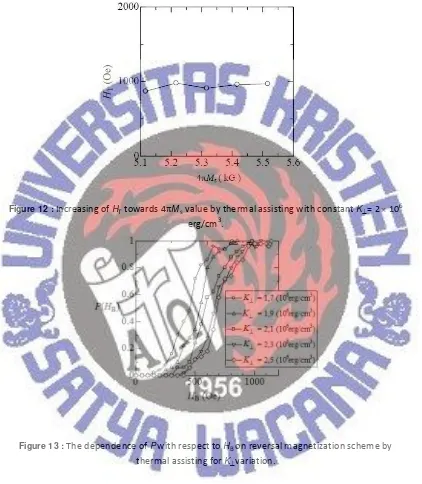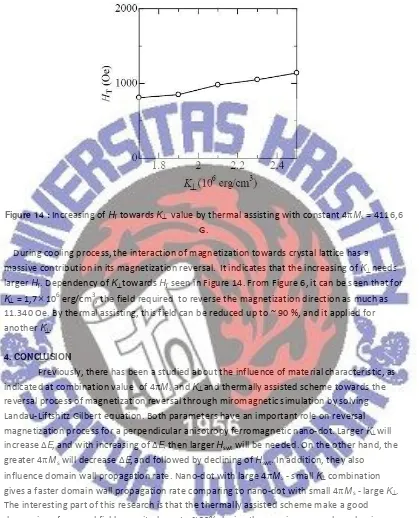M ICROM AGNETIC STUDY OF THERM ALLY ASSISTED M AGNETIZATION
REVERSAL M ECHANISM ON PERPENDICULARLY M AGNETIC ANISOTROPY
CoXSiYBZ
Oleh,
Agustina Candra Dew i Permatasari NIM : 192009003
TUGAS AKHIR
Diajukan kepada Program Studi Pendidikan Fisika, Fakultas Sains dan M atematika guna memenuhi sebagian dari persyaratan untuk mencapai gelar Sarjana Pendidikan
Program Studi Pendidikan Fisika
Fakultas Sains dan M atematika Universitas Kristen Satya W acana
Kata Pengantar
Puji dan Syukur kepada Tuhan Yesus Kristus Sang Juru Selamat, karena atas berkat dan kasih-Nya yang sungguh luar biasa sehingga penulis dapat menyelesaikan Tugas Akhir dengan baik. Skripsi ini ditulis dan disusun untuk memenuhi sebagian persyaratan memperoleh gelar sarjana pendidikan (S.Pd) Fisika di Universitas Kristen Satya Wacana Salatiga.
Dalam penyusunan skripsi ini, tidak lepas dari bantuan dan dukungan berbagai pihak. Atas segala bantuan dan dukungan tersebut, pada kesempatan kali ini penulis mengucapkan terima kasih kepada :
1. Bapak Ferdy S. Rondonuwu, selaku dosen dan wali studi. Terima kasih telah menjadi orangtua saya selama kuliah di Universitas Kristen Satya Wacana, semoga Bapak sekeluarga selalu diberkati.
2. Bapak Nur Aji Wibowo, selaku dosen dan pembimbing 1, yang telah bersedia meluangkan waktu, memberikan tenaga, masukan, dorongan semangat, semua ilmu mengenai tugas akhir ini, serta pembelajaran yang sangat berharga mengenai kedisiplinan waktu maupun target dalam menulis tugas akhir ini sehingga dapat selesai tepat sesuai rencana. Terimakasih Pak, atas semuanya itu. Semoga Tuhan Yesus Kristus selalu beserta Bapak sekeluarga.
3. Bapak Suryasatriya Trihandaru, selaku dosen dan pembimbing 2, terima kasih atas pendalaman yang diberikan untuk tugas akhir ini dan bersedia meluangkan waktu untuk bimbingan di sela-sela kesibukan. untuk dukungan doa, sharing, semangat, dan bantuan materiil yang diberikan, sehingga penulis dapat menyelesaikan kuliah dan skripsi dengan baik.
6. Keluarga Selfrimus, dimanapun mereka berada. Terima kasih untuk dukungan doa serta motivasi yang sangat kuat untuk lulus bulan Juli. You are the best for me.
7. Laboran-laboran yang selalu direpotkan. Mas Tri, Mas Sigit dan Pak Tafid terimakasih atas kesabaran menghadapi penulis yang banyak maunya dan cerewet. Semoga semuanya selalu diberkati Tuhan Yesus.
9. Teman-teman Fisika dan Pendidikan Fisika angkatan 2009 yang tidak dapat disebutkan satu-satu. Terimakasih kawan atas semua kisahnya dan menemani penulis hingga skripsi dapat selesai.
Tugas akhir yang dibuat ini belumlah sempurna, sehingga kritik dan saran yang membangun sangat dibutuhkan dalam penyempurnaan ke depan.
Salatiga, 27 Juni 2013
M OT T O
“ Success is a st at e of mind. I f you want success,
st art t hinking of yourself as a success. "
D i p er sem ba h k a n k ep a d a :
1.Allah Bapa di surga, Yesus Kristus dan Bunda Maria juru slamatk u.
M icromagnetic Study of Thermally Assisted M agnetization Reversal
M echanism on Perpendicularly M agnetic Anisotropy CoXSiYBZ
Agustina Candra D.P, Suryasatriya Trihandaru, Nur Aji W ibow o Satya Wacana Christian University, Faculty of Science and Mathematic,
52-60 Diponegoro, Salatiga 50711, Jawa Tengah, Indonesia
gst [email protected] examined using Landau-Lift shit z Gilbert equat ion. Perpendicular M agnet ic Anisot ropy is used t o realize st orage medium w it h sizable capacit y. How ever, it has a disadvant age in t he need of a large w rit ing field. Providing of heat can be used as a solut ion t o lessen magnit ude of w rit ing field. At room t emperat ure, combinat ion value of anisot ropy const ant and sat urat ion magnet izat ion give impact t o energy barrier, sw it ching field and domain w all propagat ion rat e in magnet izat ion reversal. When nano-dot is heat ed at Curie t emperat ure t hen cooled abrupt ly unt il room t emperat ure, w rit ing field is needed t o reverse t he magnet izat ion has been successf ully reduced up t o ~ 90%.
Keyw ord: anisotropy constant, saturation magnetization, probability, domain wall and reversal field.
1. INTRODUCTION
The rapid development of Personal Computer (PC) is mainly caused by the human needs of processing data and information using PC. One motivating aspect in the development of PC is the worldwide needs of the existence of a storing media with massive capacity and high speed in reading and writing abilities. In 2006, Perpendicular Magnetic Recording (PMR) was introduced as a new technology of a magnetic recording of hard drive which unitizes Perpendicular Magnetic Anisotropy (PMA) as storing media. This technology offer a bigger capacity, better ability and endurance. In PMR, the magnetic bits direction are perpendicular to its surface. Whereas in the conventional recording technology, Longitudinal Magnetic Recording (LMR) which developed, its magnetic bits was arranged parallel to the surface, so that, a larger area is needed in storing the information [1][2]. However, in PMR technology, a greater energy is required in reversing the direction of magnetized composer bits. A promising alternative solution that can be used to reduce the energy is by giving an amount of heat during the reversing magnetization [3].
2. M ETHODS
Influence of magnetic material properties to the reversal mechanism of magnetization was investigated by modeling ferromagnetic material with perpendicular magnetic anisotropy CoxSiyBz as a perpendicular magnetized nano-dot having 505020 nm3 in dimension.
Figure 1: Nano-dot models which the volume is 50 50 20 nm3 with appropnate coordinate. Chosen magnetic material parameters for CoxSiyBz are 4Ms = 4116,6 G with K= 2106
erg/cm3[4]. Magnetization reversal simulation is done by accomplishing the Landau - Liftshitz Gilbert (LLG) Equation. It contains the time derivative of the magnetization on one of side only which is shown in Eq.(1). This equation describes the magnetic material response which is characterized by the magnetization direction if it is induced by a current field [5].
M
where M as the magnetization, Msas the saturation magnetization, as the gilbert damping
constant (0.3),
0 as the gyro-magnetic ratio (1.7107/Oe-1.s-1) and Heff as the effective field.
The Heff is composed by anisotropy field (Hk), magnetostatic field (HM), the exchange
interaction field (Hex), the external field (Hext) and a random stochastic field (HT) if a thermal
field activated as seen in Eq.(2) [6].
Hieff Hki HiM HiexHexti HiT (2) Hex as an exchange stiffness constant function which described in Eq.(3)[7].
H 2 M
where Aas exchange stiffness constant (1×107erg/cm), 0as permeability of vacuum and function ofM as shown in Eq.[8].
corresponding to the x, yand zaxis.The temperature dependence of exchange stiffness can be formulated in Eq. (6)[10].
where T as actual room temperature (298 K).
Relation between Hk with anisotropy constant is expressed as a function of the unitary
The effect of temperature toward the anisotropy and saturation magnetization constant is shown in Eq.(8) and (9)[10].
with the assumed value 373 K. The thermal fluctuation field has zero mean and is assumed to be Gaussian distributed with a variance given by the fluctuation-dissipation theorem as shown in Eq. (10), Eq.(11) and Eq.(12)[11].
3. RESULT/ DISCUSSION
3.1 M agnetization Reversal at Room Temperature
Nano-dot ferromagnetic with perpendicular anisotropy which analyzed numerically in this research magnetized upward, perpendicularly to its surface along +x(M). In the scheme of micromagnetic simulation of writing process through declining energy barrier mechanism, nano-dot is conditioned at the room temperature and then induced by a bias magnetic field (HB) opposite to its initial magnetization with linearly increasing size from 0 to 20 kOe during
2,5 ns as shown in Figure 2.
Figure 2 :Scheme of micromagnetic simulation of the writing process through mechanism of declining energy barrier.
In order to reverse the nano-dot magnetization into –x direction (M), bias magnetic field in –xorientation is needed to overcome an energy barrier inside. This energy barrier separates two minimum energy level, which representing the direction of upward and downward magnetization as seen in Figure 3.
Figure 4:Magnetization reversal mechanism occurred in perpendicular magnetized nano-dot at room temperature (298K).
Figure 4 shows that the reversal process is represented through the value of Mx/Ms. Mxand
Ms are the actual magnetization in the x axis and initial magnetization respectively. For Mx/Ms =
1, magnetization of nano-dot saturated in +x direction. While for Mx/Ms= 0, nano-dot
magnetization is perpendicularly oriented to its initial magnetization and/or the number of upward and downward magnetic moment is equal so that they cancel each other. In other words, the nano-dot magnetization exactly will reverse and then this point is called as a switching point, whereas the current magnetic field and time related to this point is called as switching field (Hswt) and switching time (tswt). Explicitly, Hswtand tswt are the minimum bias field
and time are needed to switch the magnetization. Mx/Ms= 1 shows that magnetization of the
nano-dot is saturated toward the external magnetic field direction.
t = 1,087 ns t = 1,130 ns t = 1,222 ns t = 1,333 ns t= 1,521 ns
Figure 5 visualizes the nano-dot magnetization at room temperature for 4Ms = 5316,6 G
and K= 2 106erg/cm3. Black color illustrate the magnetization which aligned in HB direction,
whereas white color shows the initial direction of magnetization. Magnetization reversal of nano-dot occurred through domain wall nucleation from its center, continuing on its edge-center. This domain walls propagate up to saturated parallel to HB direction. The middle region
of the nano-dot is easier to be reversed rather than its edge caused of domination of exchange field in the middle. Whereas at the edge, reversal mechanism are led by anisotropy field. The changing of material characteristic with K variation influences ΔEand Hswt , as seen in
Figure 6. Increasing of K causes ΔEand Hswt also accrue. The reason is that increasing of
bonding of atomic moment with crystal lattice as a consequence of large K needs a substantial energy to reverse the magnetization.
Except K parameter that influences the ΔE and Hswt values, variances of ΔE and Hswt
magnitudes also affected by saturation magnetization constant (4Ms), as seen in Figure 7. A
substance that has a substantial 4Msvalue, it has a tiny ΔE, thus it needs a bit ofHswt.
Figure 6:Raising of energy barrier (ΔE) and switching field (Hswt) towards Kvalue at room
Figure 7:Decreasing of ΔEandHswtvalues towards saturation magnetization on room
t = 1,917 ns t = 1,965 ns t = 2,036 ns t = 2,114 ns t = 2,195 ns
Figure 8 :Visualization of reversal magnetization for CoxSiyBzmaterial with 4Ms = 4116,6 G
with K= 2,5106erg/cm3at room temperature (298 K).
t = 1,027 ns t = 1,065 ns t = 1,132 ns t = 1,268 ns t = 1,475 ns
Figure 9 :Visualization of reversal magnetization for CoxSiyBzmaterial with 4Ms = 5516,6 G
with K= 2106erg/cm3at room temperature (298 K).
Figure 8 and 9 describe visualization of reversal magnetization of ferromagnetic nano-dot at room temperature for two different characteristic materials, i.e. small 4Ms - large K and
small K - large 4Ms respectively. Nucleation and propagation profile of domain wall that
occurs for both materials are identical, however, rate of domain wall propagation is faster for materials with large 4Ms- small K(5116,6 G and 2106erg/cm3) i.e. 1,110 ns. Mean while,
for small 4Ms - large K(4116,6 G and 2,510 6
erg/cm3), it require longer time, i.e. 2,045 ns to reverse.
3.2 M agnetization Reversal w ith Activating Thermal
In second part of this paper concerning to investigation of reversal magnetization with support of heat. Meantime, the performed scheme is as follows, nano-dot is heated at Curie temperature, then cooled abruptly in 2,5 ns until reaching the room temperature 298 K under influence of constant HBat +xdirection, just as seen in Figure 10. Heating causes both, field
and initial magnetization turns to be random, therefore, the calculation should be performed using 50 different random numbers. Probability of magnetization with direction parallel to HB
after cooling process for 50 random numbers called is as reversal probabilityP. As seen in Figure 11, switching probability is a function of bias field. The minimum HBthat required to
reach the probability equal to 1 called as Threshold Field (HT).
A swift cooling, in fact, has not been able to magnetize nano-dot spontaneously at +x direction. As shows in the value of P(HB) = 0 whileHB= 0. Furthermore, HBthat less than 250
Oe. HT is achieved, when HBas much as 870 Oe, 980 Oe, 910 Oe, 960 Oe, and 970 Oe for each
4Msconsecutively from 5116,6 G to 5516,6 G.
0 1 2
t (ns)
Tc
HB
Figure 10 :Simulation scheme on reversal magnetization with support of heat.
Figure 11 :Dependence ofP with respect to HBon reversal magnetization scheme with heat
activation for five different value of 4Ms.
The size of HT towards value of 4Ms tends to fluctuate as seen in Figure 12. Effect of
thermally assisted plays a pivotal role in magnetization process during the cooling process, and as a result, the influence of initial nano-dot magnetization is eliminated. Supplying of heat has successfully decreases the reversal field up to ~90% for 4Msvalue about 5116,6 G to 5516,6
G.
Figure 13 displays the influence of HBonP(HB) for several different K. When HBis less than
150 Oe for all Kvalue of P(HB) = 0. The field that has 150 Oe value considered as a beginning
for 50 random numbers when HBreaching 810 Oe, 850 Oe, 980 Oe, 1050 Oe and 1140 Oe for
respectively of K from 1,7106 erg/cm3to 2,5106 erg/cm3 .
Figure 12 :Increasing of HTtowards 4Msvalue by thermal assisting with constantK= 2106
erg/cm3.
Figure 13 :The dependence of Pwith respect to HBon reversal magnetization scheme by
Figure 14 :Increasing of HTtowards K value by thermal assisting with constant 4Ms= 4116,6
G.
During cooling process, the interaction of magnetization towards crystal lattice has a massive contribution in its magnetization reversal. It indicates that the increasing of Kneeds larger HT. Dependency of Ktowards HTseen in Figure 14. From Figure 6, it can be seen that for
K= 1,7106erg/cm3, the field required to reverse the magnetization direction as much as 11.340 Oe. By thermal assisting, this field can be reduced up to ~ 90 %, and it applied for another K.
4. CONCLUSION
Previously, there has been a studied about the influence of material characteristic, as indicated at combination value of 4MsandKand thermally assisted scheme towards the
reversal process of magnetization reversal through miromagnetic simulation by solving Landau-Liftshitz Gilbert equation. Both parameters have an important role on reversal magnetization process for a perpendicular anisotropy ferromagnetic nano-dot. Larger Kwill
increase ΔE,and with increasing of ΔE,then larger Hswtwill be needed. On the other hand, the
greater 4Mswill decrease ΔE, and followed by declining ofHswt. In addition, they also
influence domain wall propagation rate. Nano-dot with large 4Ms- small Kcombination
gives a faster domain wall propagation rate comparing to nano-dot with small 4Ms- large K.
The interesting part of this research is that the thermally assisted scheme make a good decreasing of reversal field magnitude up to ~ 90% during the ongoing reversal mechanism.
5. REFERENCE
[2] J.H Judy. Past, “Present and future of perpendicular magnetic recording,” Journal of Magnetism and Magnetic Materials, CCXVL, pp. 235–240, 2001.
[3] Sousa RC, Prejbeanu IL, “Non-volatile magnetic random access memories (MRAM),” Comptes Rendus Physique (6), pp.1013-1021, 2005.
[4] J. S. Park and H. I. Yim, J. Y. Hwang and S. B. Lee, T. W. Kim, “Perpendicular Magnetic Anisotropy of CoSiB/Pt Multilayers,” Journal of the Korean Physical Society, LVII (6), pp. 1672-1674, 2010.
[5] Dmitri V. Berkov, Handbook of magnetism and advance magnetic materials : magnetization dynamics including thermal fluctuation basic phenomenology, fast remagnetization processes and transitions over high energy-barriers, Innovent technology development Germany, 2007.
[6] T. Schrelf, J. Fidler, D.Suess, W. Scholz, and V. Tsiantos, Handbook of magnetic materials: micro magnetic simulation of dynamic and thermal effects, Tsihua University Press, 2006. [7] L’ubomir Banas, “Numerical Methods for the Landau-Liftshitz-Gilbert equation,” in
Numerical Analysis and Its Applications, pp.158-165, 2005.
[8] Y. Nakatani, Y. Uesaka, N. Hayashi, “Direct solution of the Landau-Lifshitz-Gilbert equation for micromag-netics,” Japanese Journal of Applied Physics, XXVIII, pp.2485-2507.
[9] D.E.S. Stanescu, Magnetization Dynamics in Magnetic Nanostuctures, Thèse, Docteur De L’universite Joseph Fourier, 2003.
[10] Y. Nosaki, Y. Isowaki, A. Hashimoto, B. Purnama, K.Matsuyama, “Numerical analysis of thermally assisted magnetization reversal in rectangular MRAM cell consisted of exchange coupled bilayer,” Journal Magnetic Soc., XXX, pp.574-577, 2006.
Skripsi ini telah dipublikasikan di Internasional Journal of Science and Research (IJSR), Volume2 Issue 5, Halaman 48-52 Mei 2013, India Online ISSN : 2319-7064 dengan judul
“M icromagnetic Study of Thermally Assisted M agnetization Reversal
M echanism on Perpendicularly M agnetic Anisotropy CoXSiYBZ”
Alamat jurnal : www.ijsr.net
